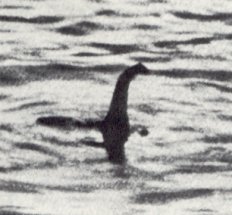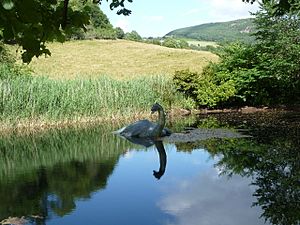Loch Ness Monster facts for kids
|
The "surgeon's photograph" of 1934, now known to have been a hoax
|
|
| Similar creatures | Champ, Ogopogo, Altamaha-ha |
|---|---|
| Other name(s) | Nessie, Niseag |
| Country | Scotland |
| Region | Loch Ness, Scottish Highlands |
The Loch Ness Monster, often called Nessie, is a mysterious animal. People say it lives in Loch Ness, a very large lake in Scotland. The story of the Loch Ness Monster became very famous in the field of cryptozoology. Cryptozoology is the study of hidden or unknown animals.
Most scientists believe Nessie is not real. They think many sightings are either tricks or people mistaking other animals for the monster. However, some people who believe in Nessie think it might be a plesiosaur. This was a large, meat-eating reptile that lived in the water a very long time ago. People have also described Nessie as an elephant, a giant eel, or other creatures.
Contents
Famous Sightings and Hoaxes
Over the years, many people have claimed to see Nessie. Some of these sightings have turned out to be hoaxes, which are tricks or jokes.
The Surgeon's Photograph (1934)
One of the most famous photos of Nessie was taken in 1934. It was called the "Surgeon's photograph" because a doctor named Robert Kenneth Wilson supposedly took it. The picture showed a small head and neck sticking out of the water. It was published in a newspaper called the Daily Mail.
For many years, this photo was seen as proof of Nessie. But in 1994, it was revealed to be a hoax. It was actually a toy submarine with a fake head and neck attached! A man named Christian Spurling built it. He was helping his father-in-law, Marmaduke Wetherell, play a trick on the newspaper. Wetherell was angry at the Daily Mail for making fun of him.
The photo was very convincing for a long time. Experts later looked closely at the original picture. They found that the ripples in the water were too small for a huge creature. This suggested the object was actually quite tiny, only about 60 to 90 centimeters (2 to 3 feet) long.
Other Hoaxes and Tricks
Many other hoaxes have been tried over the years.
- In 1933, a big-game hunter named Marmaduke Wetherell claimed to find Nessie's footprints. But these turned out to be from a hippopotamus umbrella stand! Someone had used it to make fake prints.
- In 1972, a zoo team found a large body floating in the loch. It looked like a strange creature. But it was actually a bull elephant seal that had died. A zoo worker had shaved its whiskers and changed its look to trick his friends.
- In 2004, a TV show used special effects to create a fake plesiosaur model. They called it "Lucy." Even though it was fake, many people reported seeing something in the loch where Lucy was placed.
- In 2005, two students claimed to find a giant tooth from Nessie. They even made a website about it. But experts quickly found out it was just an antler from a small deer. This was a trick to promote a horror book.
Scientific Searches for Nessie
Scientists have used different methods to search for the Loch Ness Monster.
Operation Deepscan (1987)
In 1987, a big search called "Operation Deepscan" took place. Twenty-four boats used echo sounding equipment across the loch. This equipment sends out sound waves to find objects underwater. Scientists reported finding sonar contact with a large, unknown object. Some thought it might be debris or even seals that had entered the loch.
BBC Search (2003)
In 2003, the BBC sponsored a large search using 600 sonar beams. They also used satellite tracking. This search was very detailed, even able to find a small buoy. But they did not find any large animal. The scientists involved said this proved the Loch Ness Monster was a myth.
DNA Survey (2018)
In 2018, an international team of scientists did a DNA survey of Loch Ness. They collected water samples to look for DNA from different animals. The results came out in 2019. They found no DNA from large fish like sharks or catfish. They also found no DNA from otters or seals.
However, they found a lot of eel DNA. The lead scientist, Professor Neil Gemmell, said he couldn't rule out the idea of very large eels living in the loch. But he also said no giant eels have ever been caught. He added that they found no DNA from any reptiles. This means it's very unlikely a giant scaly reptile, like a plesiosaur, is swimming in Loch Ness.
Possible Explanations for Sightings
Many ideas have been suggested to explain what people might be seeing when they think they spot Nessie.
Misidentified Animals
- Eels: Large European eels live in Loch Ness. A very big eel could explain many sightings.
- Elephants: Some people think the "surgeon's photograph" might have been a swimming elephant. Traveling circuses used to let elephants bathe in the loch. An elephant's trunk could look like a head and neck, and its body like humps.
- Greenland Sharks: These sharks can grow up to 6 meters (20 feet) long. They live in cold ocean waters, but some scientists think they could survive in fresh water like Loch Ness.
- Wels Catfish: These are very large freshwater fish. One expert suggested that a huge Wels catfish, released long ago, could be mistaken for Nessie.
- Other Animals: Otters and deer swim in the loch. Sometimes, photos of these animals have been mistaken for the monster. Birds can also be mistaken for a "head and neck" sticking out of the water.
Misidentified Objects or Effects
- Boat Wakes: Sometimes, the ripples left by boats can look strange. Even when no boats are nearby, wind can create unusual waves.
- Trees: Large tree trunks can float in the loch. When they decay, gases can build up and make them pop to the surface. Their shape, with branches, can look like a creature.
- Seiches: Loch Ness is very long and straight. This means it can have unusual waves called "seiches." These are like sloshing water in a bathtub. They can make the water surface look strange.
- Optical Effects: The way light reflects off the water, or how the air distorts images, can make objects look bigger or different than they are. A rock might look like a head and neck from far away.
- Seismic Gas: Loch Ness is located along a fault line in the Earth's crust. Sometimes, gas can be released from the fault, causing disturbances on the water's surface. This might be mistaken for something swimming.
Folklore and Legends
Some people believe that the Loch Ness Monster stories come from old Scottish legends. These legends often talk about "kelpies" or "water horses." These were mythical creatures that lived in lakes and were sometimes used to scare children away from dangerous waters. Over time, these legends might have changed to describe something more like a plesiosaur.
Images for kids
See also
 In Spanish: Monstruo del lago Ness para niños
In Spanish: Monstruo del lago Ness para niños






